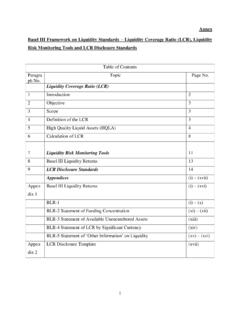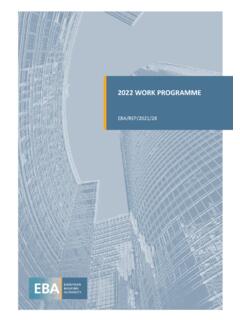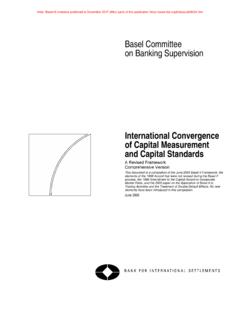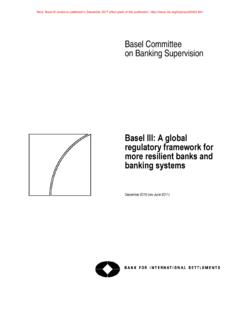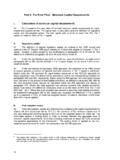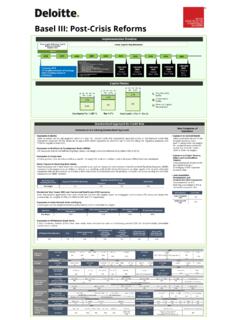Transcription of Basel Committee on Banking Supervision
1 Basel Committee on Banking Supervision High-level summary of Basel III reforms December 2017 This publication is available on the BIS website ( ). Bank for International Settlements 2017. All rights reserved. Brief excerpts may be reproduced or translated provided the source is stated. ISBN 978-92-9259-118-2 (online) High-level summary of Basel III reforms iii Contents Standardised approach for credit risk .. 2 Internal ratings-based approaches for credit risk .. 5 Removing the use of the advanced IRB approach for certain asset classes .. 5 Specification of input floors .. 5 Additional enhancements .. 6 CVA risk framework .. 7 Operational risk framework .. 8 Leverage ratio framework .. 9 Buffer for global systemically important banks .. 9 Refinements to the leverage ratio exposure measure .. 9 Output floor .. 11 Transitional arrangements.
2 12 High-level summary of Basel III reforms 1 This note summarises the main features of the finalised Basel III reforms. The standards text, which provides the full details of the reforms, is published separately and is available on the BIS website at The Basel III framework is a central element of the Basel Committee s response to the global financial crisis. It addresses a number of shortcomings in the pre-crisis regulatory framework and provides a foundation for a resilient Banking system that will help avoid the build-up of systemic vulnerabilities. The framework will allow the Banking system to support the real economy through the economic cycle. The initial phase of Basel III reforms focused on strengthening the following components of the regulatory framework : improving the quality of bank regulatory capital by placing a greater focus on going-concern loss-absorbing capital in the form of Common Equity Tier 1 (CET1) capital; increasing the level of capital requirements to ensure that banks are sufficiently resilient to withstand losses in times of stress; enhancing risk capture by revising areas of the risk-weighted capital framework that proved to be acutely miscalibrated, including the global standards for market risk, counterparty credit risk and securitisation; adding macroprudential elements to the regulatory framework , by: (i) introducing capital buffers that are built up in good times and can be drawn down in times of stress to limit procyclicality.
3 (ii) establishing a large exposures regime that mitigates systemic risks arising from interlinkages across financial institutions and concentrated exposures; and (iii) putting in place a capital buffer to address the externalities created by systemically important banks; specifying a minimum leverage ratio requirement to constrain excess leverage in the Banking system and complement the risk-weighted capital requirements; and introducing an international framework for mitigating excessive liquidity risk and maturity transformation, through the Liquidity Coverage Ratio and Net Stable Funding Ratio. The Committee s now finalised Basel III reforms complement these improvements to the global regulatory framework . The revisions seek to restore credibility in the calculation of risk-weighted assets (RWAs) and improve the comparability of banks capital ratios by: enhancing the robustness and risk sensitivity of the standardised approaches for credit risk, credit valuation adjustment (CVA) risk and operational risk; constraining the use of the internal model approaches, by placing limits on certain inputs used to calculate capital requirements under the internal ratings-based (IRB) approach for credit risk and by removing the use of the internal model approaches for CVA risk and for operational risk; introducing a leverage ratio buffer to further limit the leverage of global systemically important banks (G-SIBs); and replacing the existing Basel II output floor with a more robust risk-sensitive floor based on the Committee s revised Basel III standardised approaches.
4 2 High-level summary of Basel III reforms Standardised approach for credit risk Credit risk accounts for the bulk of most banks risk-taking activities and hence their regulatory capital requirements. The standardised approach is used by the majority of banks around the world, including in non- Basel Committee jurisdictions. The Committee s revisions to the standardised approach for credit risk enhance the regulatory framework by: improving its granularity and risk sensitivity. For example, the Basel II standardised approach assigns a flat risk weight to all residential mortgages. In the revised standardised approach mortgage risk weights depend on the loan-to -value (LTV) ratio of the mortgage; reducing mechanistic reliance on credit ratings, by requiring banks to conduct sufficient due diligence, and by developing a sufficiently granular non-ratings-based approach for jurisdictions that cannot or do not wish to rely on external credit ratings; and as a result, providing the foundation for a revised output floor to internally modelled capital requirements (to replace the existing Basel I floor) and related disclosure to enhance comparability across banks and restore a level playing field.
5 The revisions to the standardised approach for credit risk, relative to the existing standardised approach, are outlined in Table 1. In summary, the key revisions are as follows: A more granular approach has been developed for unrated exposures to banks and corporates, and for rated exposures in jurisdictions where the use of credit ratings is permitted. For exposures to banks, some of the risk weights for rated exposures have been recalibrated. In addition, the risk-weighted treatment for unrated exposures is more granular than the existing flat risk weight. A standalone treatment for covered bonds has also been introduced. For exposures to corporates, a more granular look-up table has been developed. A specific risk weight applies to exposures to small and medium-sized enterprises (SMEs). In addition, the revised standardised approach includes a standalone treatment for exposures to project finance, object finance and commodities finance.
6 For residential real estate exposures, more risk-sensitive approaches have been developed, whereby risk weights vary based on the LTV ratio of the mortgage (instead of the existing single risk weight) and in ways that better reflect differences in market structures. For retail exposures, a more granular treatment applies, which distinguishes between different types of retail exposures. For example, the regulatory retail portfolio distinguishes between revolving facilities (where credit is typically drawn upon) and transactors (where the facility is used to facilitate transactions rather than a source of credit). For commercial real estate exposures, approaches have been developed that are more risk-sensitive than the flat risk weight which generally applies. For subordinated debt and equity exposures, a more granular risk weight treatment applies (relative to the current flat risk weight).
7 For off-balance sheet items, the credit conversion factors (CCFs), which are used to determine the amount of an exposure to be risk-weighted, have been made more risk-sensitive, including the introduction of positive CCFs for unconditionally cancellable commitments (UCCs). High-level summary of Basel III reforms 3 Overview of revised standardised approach to credit risk Table 1 Exposures to banks Risk weights in jurisdictions where the ratings approach is permitted External rating AAA to AA A+ to A BBB+ to BBB BB+ to B Below B Unrated Risk weight 20% 30% 50% 100% 150% As for SCRA below Short-term exposures Risk weight 20% 20% 20% 50% 150% As for SCRA below Risk weights where the ratings approach is not permitted and for unrated exposures Standardised Credit Risk Assessment Approach (SCRA) grades Grade A Grade B Grade C Risk weight 40%1 75% 150% Short-term exposures 20% 50% 150% Exposures to covered bonds Risk weights for rated covered bonds External issue-specific rating AAA to AA A+ to BBB BB+ to B Below B Risk weight 10% 20% 50% 100% Risk weights for unrated covered bonds Risk weight of issuing bank 20% 30% 40% 50% 75% 100% 150% Risk weight 10% 15% 20% 25% 35% 50% 100% Exposures to general corporates Risk weights in jurisdictions where the ratings approach is permitted External rating of counterparty AAA to AA A+ to A BBB+ to BBB BB+ to BB Below BB Unrated Risk weight 20% 50% 75% 100% 150% 100% or 85% if corporate SME Risk weights where rating approach is not permitted SCRA grades Investment grade All other General corporate (non-SME) 65% 100% SME general corporate 85% Exposures to project finance, object finance and commodities finance Exposure (excluding real estate)
8 Project finance Object and commodity finance Issue-specific ratings available and permitted Same as for general corporate (see above) Rating not available or not permitted 130% pre-operational phase 100% operational phase 80% operational phase (high quality) 100% 1 A risk weight of 30% may be applied if the exposure to the bank satisfies all of the criteria for Grade A classification and in addition the counterparty bank has (i) a CET1 ratio of 14% or above; and (ii) a Tier 1 leverage ratio of 5% or above. 4 High-level summary of Basel III reforms Retail exposures excluding real estate Regulatory retail (non-revolving) Regulatory retail (revolving) Other retail Transactors Revolvers Risk weight 75% 45% 75% 100% Residential real estate exposures LTV bands Below 50% 50% to 60% 60% to 70% 70% to 80% 80% to 90% 90% to 100% above 100% Criteria not met General RRE Whole loan approach RW 20% 25% 30% 40% 50% 70% RW of counterparty Loan-splitting approach2 RW 20% RW of counterparty RW of counterparty Income-producing residential real estate (IPRRE) Whole loan approach RW 30% 35% 45% 60% 75% 105% 150% Commercial real estate (CRE) exposures General CRE Whole loan approach LTV 60% LTV > 60% Criteria not met Min (60%, RW of counterparty) RW of counterparty RW of counterparty Loan-splitting approach2 LTV 55% LTV > 55% Criteria not met Min (60%, RW of counterparty)
9 RW of counterparty RW of counterparty Income-producing commercial real estate (IPCRE) Whole loan approach LTV 60% 60% < LTV 80% LTV > 80% Criteria not met 70% 90% 110% 150% Land acquisition, development and construction (ADC) exposures Loan to company/SPV 150% Residential ADC loan 100% Subordinated debt and equity (excluding amounts deducted) Subordinated debt and capital other than equities Equity exposures to certain legislated programmes Speculative unlisted equity All other equity exposures Risk weight 150% 100% 400% 250% Credit conversion factors for off-balance sheet exposures UCCs Commitments, except UCCs NIFs and RUFs, and certain transaction-related contingent items ST self-liquidating trade letters of credit arising from the movement of goods Direct credit substitutes and other off balance sheet exposures CCF 10% 40% 50% 20% 100% 2 Under the loan-splitting approach, a supervisory specified risk weight is applied to the portion of the exposure that is below 55% of the property value and the risk weight of the counterparty is applied to the remainder of the exposure.
10 In cases where the criteria are not met, the risk weight of the counterparty is applied to the entire exposure. High-level summary of Basel III reforms 5 Internal ratings-based approaches for credit risk As noted above, the financial crisis highlighted a number of shortcomings related to the use of internally modelled approaches for regulatory capital, including the IRB approaches to credit risk. These shortcomings include the excessive complexity of the IRB approaches, the lack of comparability in banks internally modelled IRB capital requirements and the lack of robustness in modelling certain asset classes. To address these shortcomings, the Committee has made the following revisions to the IRB approaches: (i) removed the option to use the advanced IRB (A-IRB) approach for certain asset classes; (ii) adopted input floors (for metrics such as probabilities of default (PD) and loss-given-default (LGD)) to ensure a minimum level of conservativism in model parameters for asset classes where the IRB approaches remain available; and (iii) provided greater specification of parameter estimation practices to reduce RWA variability.










